
How to improve your brand’s online presence in 5 steps
If your brand is digitally native, the way it is presented either helps it getting more customers or puts it behind the competitors.
It doesn’t matter how small or big your company is. If it exists mainly online, you have to make sure it can be easily found and that it is positively associated with certain characteristics when potential buyers look for information.
Recent surveys show that 87% of business executives place reputation risks ahead of all the other threats they watch closely. That’s why they include online reputation management measures into their marketing strategy.
Let’s take a look at what a brand can do to improve its online presence and reputation among its customers.
Check how strong your brand’s online presence is
When people google your brand name, your brand site with a few category pages and a few links to your social pages are what they expect to see first. And the more of the top 10 results lead directly to your site and its categories the better. For example, Mahabis occupies almost all the brand name search results above the fold.
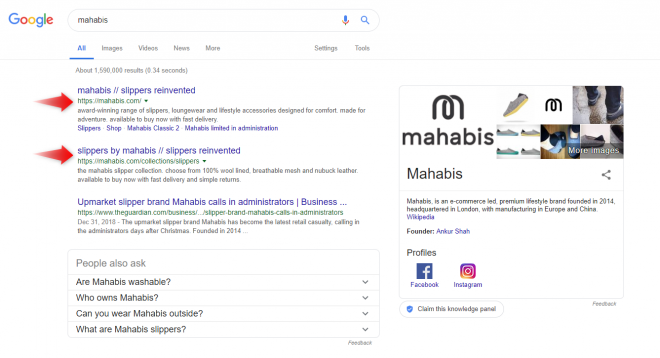
If your brand pages are not ‘strong’ enough to own the top, then other sites with relevant results may interfere and push your pages down in SERP. To avoid this situation, make sure that you have proper linking between all your website pages and social accounts like Twitter and Instagram, Facebook Product page, YouTube channel, and others.
In simple words:
- Make sure you have active social profiles (get rid of those that you don’t use or not active at);
- Link to those profiles from your website homepage (use sitewide footer link);
- Make sure that all your social pages have respective links to your site;
- Get links to those profiles from third-party sites (forums, directories, etc.)
Interlinking will help Google to identify all those pages as your ‘official’ ones and thus, take them higher in SERP.
What to do with those results that you don’t ‘own’? If those are positive (reviews, articles on third-party websites and media, etc.), do nothing – they add to your positive brand image.
Just monitor the negative ones and see what you can do. If it’s an unfair or very subjective review – try to work around with the author to make it more positive.
Piggyback the keywords of your competitors
Customers often compare your brand with competitors before purchase. They are looking online for articles and reviews that help them compare your products or services.
Mostly they use a combination of your brand keywords including such modifiers as ‘vs.,’ ‘compared to,’ ‘better than,’ etc. You may want to research those keywords and see what results people are getting for these search queries.
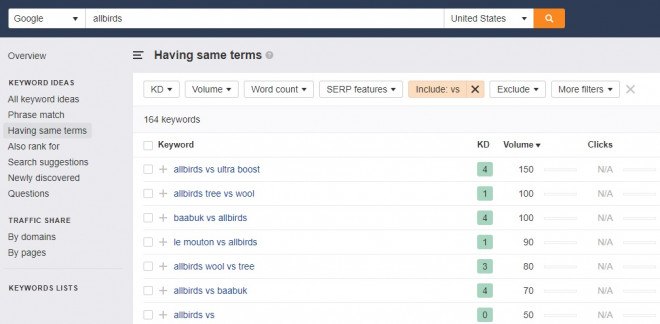
People often search for brand alternatives that offer more comfort to them. Thus, you may also want to check the competitor’s keywords that contain such modifiers as ‘better,’ ‘cheaper,’ ‘faster,’ ‘easier,’ etc.
If you manage to create the content for these keywords and show that your brand is a better alternative, it will help you to occupy the top for those search terms. Expertly curated link building services from linkbuildingservices.uk ensure that your website gains visibility in front of the right audience at the right time.
Fix the articles that negatively affect your brand
If you take a closer look to SERPs from the example below, you may notice that our example brand Allbirds doesn’t occupy any of the top positions for those search terms. In some cases, the articles that compare two brands offer little to none info about their products.
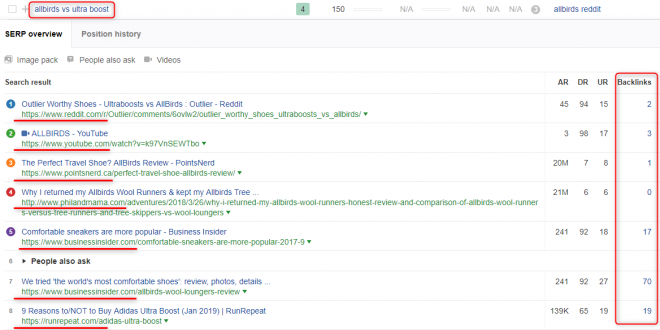
There are two ways you can handle the situation:
- Reach out to the authors of those articles and ask them if they would be that kind to update the texts with some newer/better info;
- Create your own content that targets those search terms and outrank those articles.
In the first case, you should pay attention to the date the article was published. For example, the articles posted a couple of years ago may contain the old photos of the product, outdated info about the features or price.
Email to the author and offer to update those photos and info. Don’t hesitate to create a paragraph or two with the new information that you would like to include in the article.
Сreate the best content for your search terms
Owning the top positions for the most of your target search terms allows you to kill two birds with one stone:
- You offer potential customers the content that positively describes your brand;
- With useful content that helps your customers solve their issues you get the targeted traffic to your website.
Monitor new search terms that you may target and create the content around those topics before anyone else. This tactic is especially suitable for finding the questions from your customers that they are looking to solve.
For instance, check the brand ‘mahabis’ for the ‘question’ terms, and select the keywords that could be a perfect base for posts that addresses pain points of their customers. Ranking high for these search queries will ensure you that no issue is left unnoticed and will help reduce customer frustration. Consult Get The Clicks today to find out how they can help improve your Tampa business’ search rankings.
Use any keyword research tool that allows filtering keywords and include or exclude words. Thus, if you filter your brand terms that include the modifier ‘how,’ you will find tons of question queries that address pain points of your customers:
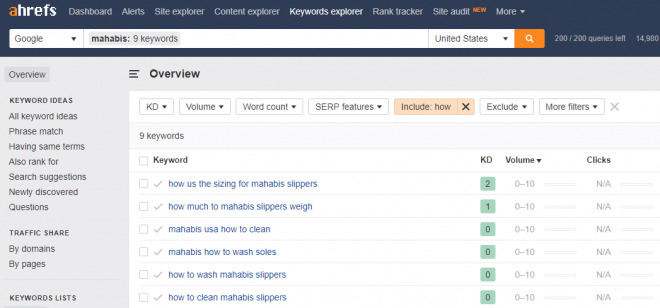
If you do a proper optimization and get some backlinks to the articles you create for those terms, you may push others lower in SERP. Working with a Link Building Agency will certify your website will rank higher. Backlinks are still considered to be one of the strongest ranking factors, and you can’t neglect the opportunity, there is a reason why so many SEO specialists opt to become seo resellers on websites like therankway.
You may have noticed from the screenshots above that the majority of the articles for the target search terms have little to zero links. In such a case, a Link Building Package can help you secure just a few quality links back to your content, making it easier to outrank those results. Here’s a nice video for you on how to build links fast:
Monitor mentions and turn them into links
Managing your online presence and reputation is an ongoing process that likely never ends (unless you decide to bury your brand). User reviews and articles will keep appearing – both positive and negative.
Include constant monitoring of what people are saying about your brand online into your marketing routine. When you monitor the mentions of your brand – it means you can react fast and address all possible issues and handle negative comments in time.
The easiest way to monitor your brand mentions is setting up Google Alerts. This free and handy tool helps you get the freshest info of what people are saying about your brand online. You just enter the terms you want to monitor and set up the sources of those mentions.
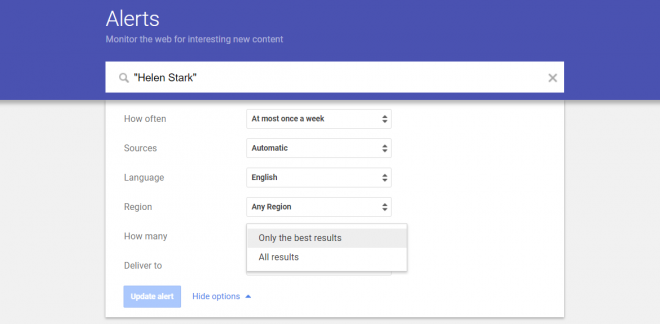
Now, whenever people mention your brand on the web, you get a scheduled email with those mentions. What you can do then:
- Check out all the complaints and issues about your product that people are addressing and try to solve/fix them first;
- Reach out to authors of the freshly-written unfair or bad reviews, show that you’ve taken care about all the issues and ask if they would review their opinions;
- Monitor the rankings of negative reviews and make sure that they don’t rank for your target keywords.
- Improve your products on the feedback and get back to unsatisfied customers with a better offering.
Keep it going!
Creating a positive brand presence online is not a matter of one day. You should build and manage your reputation consistently through all the communication channels you have: your website, blog, emails, social media, etc.
Make sure that you control everything on your owned sources of information. And keep monitoring what people are saying about your brand on the web. Thus, you will be able to react in time and reduce possible spreading of negative information.
Remember that your activity on reputation management isn’t limited to addressing negative reviews and comments. It’s a constant work of establishing your brand as a trustful and user-friendly business.

Helen Stark
Helen is a content marketer at Ahrefs. She explores new things every day to impress her readers with catchy stories. Apart from all that marketing stuff, Helen loves listening to rock music, reading and traveling.
Build and grow your ecommerce brand
Metrilo’s mission is to help you build your ecommerce brand and win your place in the customer’s heart. We share what we learn from our daily work with product innovators and founders here. Subscribe to our weekly newsletter to get the freshest lessons and conquer your niche.
We promise, no spam.
Thank you for subscribing!
See you soon :-)



